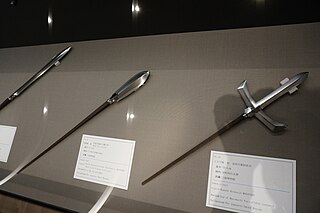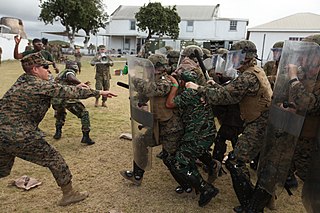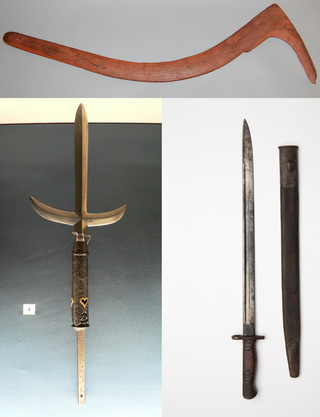
A polearm or pole weapon is a close combat weapon in which the main fighting part of the weapon is fitted to the end of a long shaft, typically of wood, extending the user's effective range and striking power. Polearms are predominantly melee weapons, with a subclass of spear-like designs fit for thrusting and/or throwing. Because many polearms were adapted from agricultural implements or other fairly abundant tools, and contained relatively little metal, they were cheap to make and readily available. When belligerents in warfare had a poorer class who could not pay for dedicated military weapons, they would often appropriate tools as cheap weapons. The cost of training was comparatively low, since these conscripted farmers had spent most of their lives using these "weapons" in the fields. This made polearms the favoured weapon of peasant levies and peasant rebellions the world over.
A war hammer is a weapon that was used by both foot soldiers and cavalry. It is a very old weapon and gave its name, owing to its constant use, to Judah Maccabee, a 2nd-century BC Jewish rebel, and to Charles Martel, one of the rulers of France. In the 15th and 16th centuries, the war hammer became an elaborately decorated and handsome weapon.

Non-lethal weapons, also called nonlethal weapons, less-lethal weapons, less-than-lethal weapons, non-deadly weapons, compliance weapons, or pain-inducing weapons are weapons intended to be less likely to kill a living target than conventional weapons such as knives and firearms with live ammunition. It is often understood that unintended or incidental casualties are risked wherever force is applied, however non-lethal weapons minimise the risk of casualties as much as possible. Non-lethal weapons are used in policing and combat situations to limit the escalation of conflict where employment of lethal force is prohibited or undesirable, where rules of engagement require minimum casualties, or where policy restricts the use of conventional force. However, these weapons occasionally cause serious injuries or death due to allergic reactions, improper use and/or other factors; for this reason the term "less-lethal" has been preferred by some organizations as it describes the risks of death more accurately than the term "non-lethal", which some have argued is a misnomer.

Yari (槍) is the term for a traditionally-made Japanese blade in the form of a spear, or more specifically, the straight-headed spear. The martial art of wielding the yari is called sōjutsu.

Riot control measures are used by law enforcement, military, paramilitary or security forces to control, disperse, and arrest people who are involved in a riot, unlawful demonstration or unlawful protest.
A rifle grenade is a grenade that uses a rifle-based launcher to permit a longer effective range than would be possible if the grenade were thrown by hand.

A glaive, sometimes spelled as glave, is a type of pole weapon with historical origins in Europe, known for its distinctive design and versatile combat applications. It is similar to other polearms such as the war scythe, the Japanese naginata, the Chinese guandao, the Korean woldo, and the Russian sovnya.

The FN 303 is a semi-automatic less-lethal riot gun designed and manufactured by Fabrique Nationale de Herstal.

A fauchard is a type of polearm which was used in Europe from the 11th through the 17th centuries. In later use fauchards became ornamental and ceremonial, growing in size until some examples were almost too heavy to carry, let alone use. The design consisted of a curved blade atop a long pole, although in some portrayals, it is shown on a shorter pole. The blade bore a moderate to strong curve along its length. The cutting edge was only on the convex side of the blade, unlike the guisarme or bill. The fauchard was likely developed from the war scythe with the cutting edge turned opposite, convex instead of concave, so that the weapon was good for both thrusting and slashing attacks.
A bec de corbin is a type of polearm and war hammer that was popular in late medieval Europe. The name is Old French for "raven's beak". Similar to the Lucerne hammer, it consists of a modified hammer's head and spike mounted atop a long pole. Unlike the Lucerne hammer, the bec de corbin was used primarily with the "beak" or fluke to attack instead of the hammer head. The hammer face balancing the beak was often blunt instead of the multi-pronged Lucerne, and the beak tended to be stouter; better designed for tearing into plate armor, mail, or gambeson. Nonetheless, some becs-de-corbin also had a multi-pronged hammer. The spike mounted on the top of the head was also not nearly as long and thin as on the Lucerne. Bec de corbin is sometimes used as a general term to describe several types of war hammer, such as mauls and horseman's picks. A similar name, bec de faucon, refers to a related weapon called a poleaxe or, more specifically, to the hook on its reverse side.

A police car is a ground vehicle used by police and law enforcement for transportation during patrols and responses to calls for service. A type of emergency vehicle, police cars are used by police officers to patrol a beat, quickly reach incident scenes, and transport and temporarily detain suspects, all while establishing a police presence and providing visible crime deterrence.

A melee weapon, hand weapon, close combat weapon or fist-load weapon is any handheld weapon used in hand-to-hand combat, i.e. for use within the direct physical reach of the weapon itself, essentially functioning as an additional extension of the user's limbs. By contrast, a ranged weapon is any other weapon capable of engaging targets at a distance beyond immediate physical contact.

For much of history, humans have used some form of cavalry for war and, as a result, cavalry tactics have evolved over time. Tactically, the main advantages of cavalry over infantry were greater mobility, a larger impact, and a higher riding position.
A monk's spade, also called a Shaolin Spade, is a Chinese polearm consisting of a long pole with a flat spade-like blade on one end and a smaller crescent shaped blade on the other. Neither blade was designed to be sharpened. In old China, Buddhist monks often carried spades (shovels) with them when travelling. This served two purposes: if they came upon a corpse on the road, they could properly bury it with Buddhist rites, and the large implement could serve as a weapon for defence against bandits. The crescent was designed as defense against small to medium-sized predators such as wild dogs and leopards. The way it is used is to hold the animal at bay by positioning the crescent at the animal's neck and pushing it away if needed. Over time, they were stylised into the monk's spade weapon.

The Simba is a wheeled armoured personnel carrier designed by GKN Sankey. It is currently in service with the Philippine Army.

The sasumata is a polearm used by the samurai class and their retainers in feudal Japan.

The tsukubō (突棒) was a polearm used by the samurai class and their retainers in feudal Japan.

The sodegarami is a polearm that was used by the samurai class and their retainers in feudal Japan.

The torimono sandōgu were known as the three tools of arresting. The torimono sandōgu were three types of pole weapons used by the samurai class and their retainers in feudal Japan during the Edo period.

In feudal Japan, individual military and citizens groups were primarily responsible for self-defense until the unification of Japan by Tokugawa Ieyasu in 1603. During the Edo period (1603–1868), the Tokugawa shogunate formed a centralized feudal government. Samurai warriors who once protected Japan from foreign enemies and fought each other for supremacy became the new police and internal security force. Their new job would be to ensure civil peace, which they accomplished for over 250 years.














